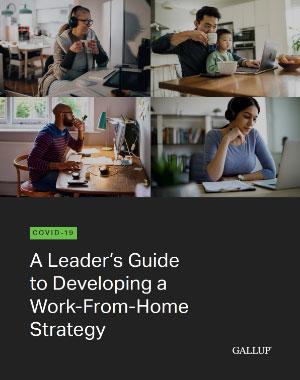Story Highlights
- After the pandemic, remote work (to some degree) will always be present
- Many companies have shifted to a "hybrid" work model
- Leaders must focus on culture when deciding where employees will work
The end of the pandemic is in sight. CHROs are divided on when that will be; some expect post-pandemic life to start this summer, others think this autumn. It certainly seems closer now than ever before. For right now, the members of Gallup's CHRO Roundtable -- the biggest group of large-company CHROs in the world -- are focusing on the impending transition into a post-pandemic world.
For many, this means integrating remote work -- at least to some degree -- permanently. But CHROs expect challenges along the way.
The Future of Work Is Flexible
Though few CHROs foresee their organizations becoming fully remote (there are notable exceptions), most expect greater work-site flexibility. In fact, some CHROs consider remote work opportunities a brand imperative, citing organizations that have already lost talent to more flexible companies. A few say their leaders have strong opinions about keeping workers on-site, but they note that productivity and engagement may decline if pandemic-era flexibility is rescinded too much or too soon.
In response, most CHROs are engineering an approach described as "flexibility within a framework" for their companies. The most popular solution by far is a mix of on-site and in-person workdays -- the well-known hybrid arrangement -- oriented toward the location, department, role and employee. So far, many companies envision employees working one to three days per week on-site to preserve the cohesion, connection and culture they had pre-pandemic.
The most popular solution by far is a mix of on-site and in-person workdays -- the well-known hybrid arrangement -- oriented toward the location, department, role and employee.
Other companies are planning an event-based schedule, where employees come together for specific occasions -- whether as a team, department, division, or organization -- monthly or yearly. One CHRO called this "intentional convening with a purpose" to share "key moments in person."
Listening to Employees While Considering Culture
As leaders analyze where employees need to be, for what and when, most CHROs report capturing employee sentiment with pulse surveys, focus groups, and the like so that decisions are made with an eye toward workers' opinions, needs, and experiences.
CHROs say their leadership teams are adding their experience, foresight, and their understanding of their company and its goals, infrastructure, and resources to that employee feedback to craft a solution that will put their best foot forward in the future of work -- "to meet employee needs with what we need at the business level," as one CHRO put it.
Some CHROs say their hybrid policies will cover every remote worker to ensure a consistent and fair employee experience. Other CHROs will empower management to individualize to the needs and preferences of employees, the nature of the work, the composition of the team, and the managers' abilities and working style. Most have realized these decisions aren't a matter of policy as much as a matter of culture.
The Corporate Costs and the Legal Realities of Remote Work
One of the primary financial benefits of large-scale remote work is the reduction of corporate costs with a smaller real-estate footprint. Some CHROs say remote work is also a talent strategy that can expand the talent pool, retain top performers, or even poach talent from less progressive companies. Even organizations that opt for a middle path when it comes to remote work -- hybrid arrangements, greater flextime, new work-life balance policies -- feature those decisions prominently in branding and talent strategy.
These new policies have implications for every facet of HR. One of the most challenging has been addressing unauthorized relocation during the pandemic.
Tracking these employees down has been an enormous headache but a necessary one: compensation, benefits and tax laws differ among states and countries. Although physically and theoretically people can work anywhere, they can't be employed everywhere, so CHROs must choose between expanding employee location options or reeling in their rogue employees.
When it comes to tethering employees in a remote world, many CHROs are opting for a hub model, which requires employees to live within driving distance of a central office location. Workers will choose their hub based on their job duties, the function of the hub and will be expected to be on-site at certain times. Though it narrows the labor pool, it substantially cuts companies' travel expenses while sustaining flexibility.
Although physically and theoretically people can work anywhere, they can't be employed everywhere, so CHROs must choose between expanding employee location options or reeling in their rogue employees.
Rebalancing Productivity and Wellbeing
Some companies reported an uptick in productivity and work hours during the pandemic, but CHROs aren't unanimously certain those numbers are sustainable. Some aren't sure they're even real -- which helps explain why some HR organizations are looking into updating performance monitoring systems for remote workers.
One thing is certain: since the onset of the pandemic, remote workers have become more susceptible to burnout -- before the pandemic, the reverse was the norm -- and negative emotions such as worry and stress have been elevated for nearly a year, according to Gallup research.
One thing is certain: since the onset of the pandemic, remote workers have become more susceptible to burnout.
Those are serious issues. Even when employees aren't experiencing burnout, CHROs worry about the impact of mounting fatigue and exhaustion on safety, engagement, productivity and culture. Regardless of the work arrangement, the future of work will require striking a new balance between productivity and wellbeing to endure -- let alone thrive.
Employee Experience and Culture in a Remote Environment
It is clear to HR leaders that designating a specific number of days for workers to be on-site is an incomplete future of work strategy. In addition to the many concrete policies they're crafting, CHROs report that their conversations revolve around less tangible issues of alignment, values, how new ways of working will feel different -- and what that means going forward. "It's the softer things we're working on," said the CHRO of a large international financial service company, "but they will be what defines the culture moving forward."
Among those "softer things" is the employee experience in a hybrid, hub or fully remote environment. Though remote options are generally a boon to recruitment, hiring and retention, most CHROs believe that a virtual workspace can hamper new hires' immersion in the culture, emotional connection to the organization and critical mentoring relationships.
It is clear to HR leaders that designating a specific number of days for workers to be on-site is an incomplete future of work strategy.
Even tenured workers will find an off-site employee experience different, and CHROs are especially concerned about their long-term development and advancement opportunities. CHROs predict that ensuring equitable on- and off-site employee experiences -- especially access to opportunities and delegation of responsibilities -- will be a challenge.
The importance of the employee experience can't be overstated. It's a big part of "how we do things around here," which is how Gallup defines workplace culture feels to people, and CHROs are concerned about safeguarding the way things are done.
Most doubt online platforms can replicate the personal relationships many cultures rely on that are historically cultivated in an in-person environment. Not that it's impossible -- in fact, many strongly encourage videoconferencing over audio-only meetings for that reason among others -- but many CHROs believe chance conversations, pre-meeting chatter and the proverbial "water cooler" gatherings spark far more of the creativity and collaboration their cultures value. To that end, the CHRO of a multinational clothing company says they're "relaunching the office" to create a space "that people want to come in."
That said, online culture is a culture and one that CHROs need to monitor. Beyond the cultural implications for cybersecurity -- which have inspired some CHROs to partner with their CIT on digital architecture to keep their companies safe and culturally flourishing -- many remote workers report feeling pressure to be available 24/7. That kind of culture is not advisable and can be amended by clearly articulated expectations of online behavior including, according to some CHROs, basic etiquette, such as signaling availability on team channels.
Online culture is a culture and one that CHROs need to monitor. Beyond the cultural implications for cybersecurity… many remote workers report feeling pressure to be available 24/7.
The novelty of online culture has caused some CHROs to think critically about the on-site/offline work experience as well. A year's absence requires reacclimating to the office, and a smooth and productive re-entry requires HR intervention. "How do we engage when we're physically in the office?" one CHRO asked. "How do we make sure there's more face-to-face interaction, more collaboration and more innovation?"
Generating Revised Health Policies
Though the post-pandemic future feels just within reach -- indeed some organizations have already launched their "new normal" work arrangements -- most medical experts agree we're far from herd immunity and Gallup's public opinion polling shows the U.S. is unlikely to reach it. So crafting smart health policies in constantly evolving national, state and local legislation is no easy task.
For example, in May 2021, CHROs scrambled to update their corporate policies to adjust for the CDC's new guidance on mask-wearing after vaccination, which does not account for state and local mask mandates, thus causing companies to vary their policies by geography.
That's comparatively easy. In areas that relax safety policies for the vaccinated, corporate leaders must either mandate proof of vaccination or allow an honors system. The former invites backlash, the latter raises safety concerns for many, including employees who -- for legitimate health reasons -- cannot be vaccinated.
CHROs worry about how vaccine opinions and practices may cause rifts among employees regardless of corporate policies, and still struggle with decisions about drafting or even communicating vaccination policies. So, aside from many healthcare organizations, most organizations do not plan to mandate COVID-19 vaccines.
However, some are opting to actively educate employees about the benefits of vaccination and encouraging vaccination for employees who can safely get one. Many organizations are incentivizing vaccinations through PTO, bonuses, contributions to wellness programs or HSA matches as well. A few companies provide free COVID-19 vaccinations in locations where employees would otherwise have to buy them.
These decisions will have a great impact on employees' experience of on-site work, wellbeing and engagement in the coming months. And the way CHROs approach these health policies now will influence the future of work in their companies -- adding yet more complexity to the task of reshaping work arrangements, talent strategies, HR functions, performance management and the employee experience.
Clearly, the future of work requires a massive intellectual paradigm shift.
The Future Mindset Requires Adaptability and Resilience
"Change fatigue" is powerful, and after a year like 2020, understandable. But as organizations wade into uncharted waters -- an increasingly apt description of business -- success depends on being energized and excited by opportunities for growth. Making peace with ongoing uncertainty is necessary for resilience. Being daunted by constant change is a bar to progress. And developing a successful attitude toward both requires a new way of thinking.
So now, with the end of the pandemic in sight, CHROs are viewing the future -- and their own cultures -- through a lens of adaptability. Some organizations have embraced the opportunity to craft a new culture of resilience, flexing the adaptability muscles they recently developed. Others are edging into the future cautiously, preserving what has always worked for them, betting that it still will.
Making peace with ongoing uncertainty is necessary for resilience. Being daunted by constant change is a bar to progress. And developing a successful attitude toward both requires a new way of thinking.
But all the members of the CHRO Roundtable are crafting their future of work strategies with the knowledge that the future of work has already begun -- and that the evolution of work is just beginning.
Employee trust is central to any remote, hybrid or in-person work strategy:
- Ensure your culture matches your new expectations for employees.
- Learn more about what CHROs from other companies are doing to prepare their people for the future of work.
- Contact a Gallup expert to talk about how you can build a better strategy that works for your employees and your organization.




